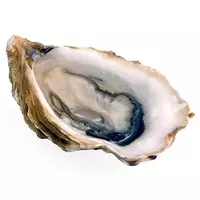Oyster

The oyster is called an edible marine bivalve mollusk. Due to the fact that he loves not very salty water, most often this mollusk can be found near the mouth of rivers in tropical seas. The taste and benefits of oysters are appreciated by many foodies, so this mollusk belongs to the elite of the gastronomic world.
First of all, the most important factor to take into account when choosing this delicacy is its freshness, since it not only depends on the presence of beneficial properties of the oyster, but also possible harm. First of all, its shell should be tightly closed, because if there is at least a tiny gap in it, it is safe to say that the oyster is rotten. If the oyster is alive, when the shell is opened, its body should flinch, if not, then the mollusk is dead and not suitable for food. Usually, a special oyster knife is used to open a mollusk.
Consuming this gift of the sea for food, oyster meat is poured with lemon juice, while most often shellfish are served raw. It is customary to drink down this exquisite seafood with dry wine or light beer. It is necessary to eat an oyster without chewing, but swallowing the whole, so to speak, "drinking" from the shell. In addition to their own dish, oysters are used as the main component in many hot dishes, salads and even desserts. The calorie content of the oyster is low and is 72 kcal per 100 grams of meat. Unfortunately, in wildlife, these elite mollusks are less and less common, so they cost more and more.
Oyster benefits
The benefit of oysters lies not only in its high nutritional value, but also in its unusual chemical composition, which determines both the excellent refined taste and the tonic effect on the nervous system. The content of vitamins, minerals, fats and protein can fully satisfy the body's daily need for essential substances. At the same time, the oyster can "boast" the presence of an extremely useful combination of fatty acids, in which omega-3 acid, which is responsible for the emotional state of a person, is not the last place.
Thanks to numerous experiments by American scientists, it was found that the benefits of oysters are obvious in the fight against breast cancer due to the content of ceramide fats. In addition, these substances not only block cancer cells, but also prevent the growth of malignant neoplasms. Raw oyster meat is also known to contain two very rare amino acids that stimulate the production of hormones responsible for sex drive.
oysters 72 kCal
Energy value of oyster (Ratio of proteins, fats, carbohydrates - ju):
Proteins: 9 g (~ 36 kCal)
Fats: 2g (~ 18kCal)
Carbohydrates: 4.5 g (~ 18 kCal)
Energy ratio (bj | y): 50% | 25% | 25%
 Español
Español Français
Français Português
Português Русский
Русский 简体中文
简体中文 繁體中文
繁體中文 日本語
日本語 한국어
한국어 العربية
العربية Türkçe
Türkçe Қазақ
Қазақ Deutsch
Deutsch Italiano
Italiano Українська
Українська
